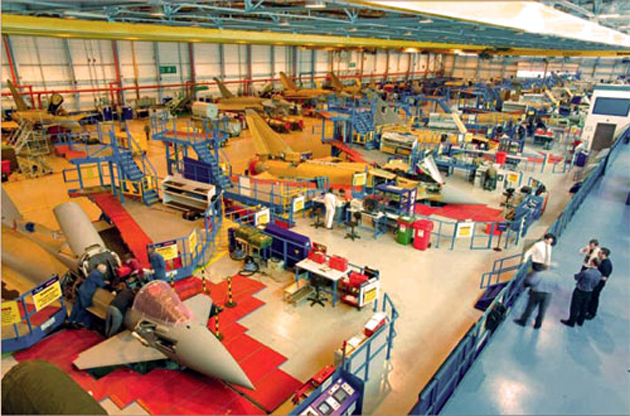By Nantoo Banerjee
It is good to note that India’s defence manufacturing industry is fast emerging as a major contributor to the country’s economy and quietly supporting the latest stock market surge. Defence manufacturers have never had it so good. The private sector defence manufacturing enterprises are doing extremely well alongside the traditional government-run publicly held armament manufacturers. The country’s 10 defence stocks surged up to 446 percent in the last one year. Among the top performers are: HAL, Mazagon Dock, Bharat Forge, Bharat Dynamics, Paras Defence and Space, Bharat Electronics, ideaForge, MTAR Technologies, Data Patterns, Solar Industries, Goa Shipyard and Taneja Aerospace.
In fact, India’s defence stocks are witnessing a bull run. The Nifty India Defence Index has, as per ACE Equity database, surged 142 percent in the 12-month period, outperforming the benchmark Nifty 50 which gave 26 percent return in the same period. Out of the total 15 stocks of the Nifty India Defence Index, as many as 14 had given positive returns to the investors. And, 10 stocks gained over 100 percent. The size of the country’s armament manufacturing market is estimated at US$17.40 billion in 2024. This is expected to reach $23.05 billion by 2029. India’s demand for arms and weapons far exceeds their domestic supply as the country continues to be the world’s top defence products importer. It is likely to remain so until the domestic defence industry is able to catch up with some of those in the world’s top armament manufacturing countries such as the US, Russia, China, the UK, Germany, France and Israel.
Until now, India’s military budget has been considerably small to feed its army, the world’s second largest after China. On paper, India’s defence budget is the fourth largest at $74 billion compared to the US ($832 billion), China ($227 billion) and Russia ($109 billion). In effect, much of India’s defence budget is spent on salaries and pensions of military personnel. Ironically, the annual defence spending of India, the world’s most populous country with 1.4 billion citizens, is close to Saudi Arabia’s military budget of $72 billion. Saudi Arabia’s total population is less than 37 million.
Considering the security scenario across India’s borders, including land, sea and aerospace, and increasing strategic expansion of China, the country’s main military detractor, in the region, its defence budget is expected to rise substantially in the coming years. The domestic defence manufacturers need to gear up strongly to meet the growing demands from the armed forces. However, high-end technologies to manufacture lethal weapons are not easily accessible. India’s Defence Research and Development Organisation (DRDO) has to work hard to provide the necessary support to the weapons manufacturers.
Thanks to the US-backed Ukraine-Russia war, Israel-Hamas battle, North Korea’s anti-Washington and anti-Seoul rhetoric and China’s constant military expansion in the Pacific and Indo-Pacific regions and the continents of Africa and South America under its Belt and Road Initiative, and the weakened status to the United Nations to deal with the contentious issues of the world peace and security, the global demands for weapons and supplies are projected to vastly increase in the coming years.
According to a recent Bloomberg report, the world rush to rearm could cost the G7 countries alone some $10 trillion over the next decade. Its listed security challenges include Russia, a volatile West Asia, and the Chinese military tagging the US attention toward the Pacific. It noted that a new era of global rearmament is gathering pace at a huge cost and some tough decisions for western governments already struggling with shaky public finances. The world defence spending reached a record $2.2 trillion last year.
Can India afford to ignore the global security concerns and continue to remain import happy to meet its requirement of advanced munitions to contain Chinese military aggression? Interestingly, China had cut down its arms imports over the past five years. China replaced foreign-built weapons with its own, manufactured with its ‘own’ technology. Chinese manufacturers remain deeply embedded within US military infrastructure. France is investigating suspected smuggling to China and Russia of advanced chip technology.
Russia still accounts for the bulk of China’s overseas arms purchase. According to the Stockholm International Peace Institute, China’s arms imports in 2019-23 dropped by 44 percent from the previous five years, putting it 10th on the list of the world’s biggest buyers of foreign weapons. Russia supplied 77 percent of China’s military purchases, including aircraft engines and helicopter systems, followed by France with 13 percent. While India remains the world’s top arms importer.
Indian investors are ready to provide support to the country’s arms manufacturing industry. The government and its DRDO need to work together to boost the domestic defence industry. The country has done reasonably well to build its own missile systems. Indigenously developed armoured vehicles, supersonic missile Brahmos, air defence system Akash, fourth generation fighter aircraft LCA Tejas are among the Indian weapon systems that have attracted interest from several foreign buyers.
India needs to do a lot more to drastically cut down arms import by building a strong and vibrant defence manufacturing industry. Consequently, defence shares in India will see a significant rise in demand, leading to potential increase in their stock prices in the coming years. The nature of the defence industry demands substantial upfront investment in high-cost machinery and R&D facilities, making it a capital-intensive endeavour. It is time that deep-pocket big industrial houses enter the defence manufacturing sector by promoting separate companies with specific product focus. The market is ready to lap up such enterprises. (IPA Service)


